Together with Employees
We work to create comfortable workplaces by enabling workers to excel while enhancing their skills.
Respect for Human Rights
Human Rights Awareness Policy and Promotion Structure
The Fuji Electric Code of Conduct calls for us to “respect and value all people.” Also, our companywide Human Rights Awareness Policy instructs us to remain aware of the rights of foreigners and individuals with mental or physical disabilities or intractable diseases. Accordingly, we strive to prevent social discrimination and all other forms of harassment.
We also have established a Group Human Rights Promotion Committee, whose members are the heads of the human resource departments of Fuji Electric and major affiliates. This committee meets regularly to promote human rights awareness across the Company.
In the future, we plan to promote human rights awareness on a global basis, including at overseas subsidiaries.
Preventing Harassment
We instituted Sexual Harassment Guidelines in April 2008. We also have established in-house consultation helpdesks, and we carry out ongoing staff training relating to harassment issues and train managers on the topic.
Human Rights Education for Employees
Fuji Electric conducts an array of courses to raise employee awareness of human rights issues. We operate a rank-based training program for department heads, and managers to equip them to deal with discrimination and other harassment issues. Furthermore, corporate officers responsible for labor relations, heads of human resource departments, and recruitment and human rights specialist staff attend workshops and other events hosted by human rights organizations.
In FY2010, we introduced a trial program to cultivate young employees in their third through fifth years at Fuji Electric as “human rights awareness instructors.” Fourteen employees participated in this program in its inaugural year, and they are scheduled to begin serving as instructors in human rights awareness programs in FY2011.
Table: People Undergoing Human Rights Training in 2010 (January–December)
| Course | Participants |
|---|---|
| Rank-based training | 789 |
| Training for employees in their first two years of service | 49 |
| Harassment training | 1,928 |
| Training by human rights and local government organizations | 15 |
Making the Most of a Diversified Workforce
Recruitment and Appointment of Employees Who Respect Diversity
Fuji Electric recruits and employs a diverse workforce and aims to cultivate corporate management that capitalizes on the variegated qualities and strengths of its employees.
We recruit new graduates and mid-career professionals without regard for gender or nationality. Moreover, we are aggressive in appointing women and locally hired employees.
Table: Regular Recruiting Results (in Japan)
| FY2009 | FY2010 | FY2011 | |
|---|---|---|---|
| University graduate | 230 (22 foreigners, 34 women) |
106 (7 foreigners, 13 women) |
126 (11 foreigners, 23 women) |
| Technical college and high school graduates |
138 (2 women) |
85 | 83 (8 women) |
| Total | 368 | 191 | 209 |
 Graph: Regular and Part-Time Employees
Graph: Regular and Part-Time Employees
Graph: Regular Employees by Region

Promoting Employment of People with Disabilities
In FY2006 in Japan, Fuji Electric established a plan to expand employment for people with disabilities. This plan calls for each company to set its own target employment rates and to promote opportunities.
In FY2010, we pursued a host of initiatives to cultivate workplace opportunities for expanding employment for people with disabilities. As of June 1, 2011, we had 275 employees with disabilities (using the counting equivalent in Japan’s Job Development Act), representing an employment rate of 1.94%, exceeding the legally mandated rate of 1.8%.
Fuji Electric Frontier Co., Ltd., established in 1994 as a special-purpose subsidiary focused on employment for people with disabilities, has begun handling new businesses such as testing new vending machines and scanning documents. In July 2010, the company participated in Yokohama Human & Technoland 2010, an event sponsored by the city of Yokohama. In October, the company also took part in the 32nd National Skill Competition for People with Disabilities (Abilympics). As of June 1, 2011, 72 employees worked for Fuji Electric Frontier.
Going forward, we are considering the establishment of Fuji Electric Frontier sites at each Fuji Electric plant.
Fuji Electric Frontier’s website (Japanese only)
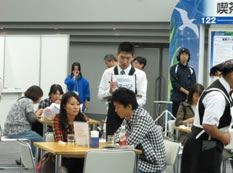
Tokyo office employees participating in the “cafe section” of the 32nd National Skill Competition for People with Disabilities
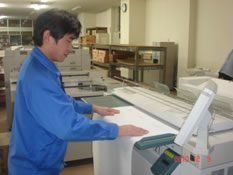
Document scanning underway at our Kawasaki site
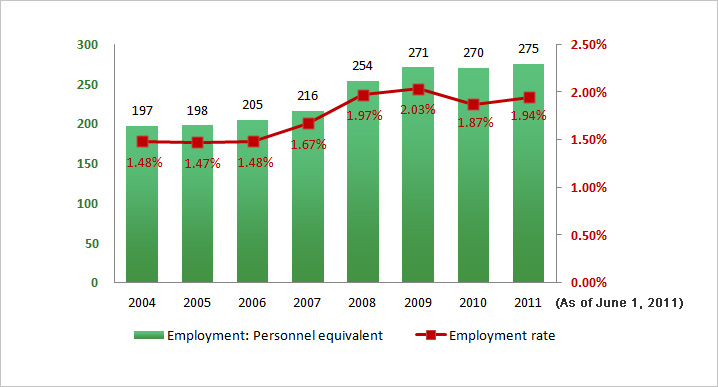
Supporting the Advancement of Female Employees
In Japan, Fuji Electric supports female employees in their career development and helps them balance the workplace and family.
In FY2010, we followed up on training that we had conducted in FY2008 to help female employees design their careers. As part of this process, 52 women in “KIKAKU SHOKU GRADEⅠ”(highest level of planning positions), including assistant managers and supervisors, met with their immediate superiors to review their activities during the past two years and set specific targets for next several years. A further 47 women in “KIKAKU SHOKU GRADE II”(middle level of planning positions) and their superiors participated in sessions to consider their career paths.
We also conducted groupwide training for women to increase their number in management positions. Fifty-five women participated in this training over a 10-day period.
As a result of these endeavors, women in managerial positions, including heads of departments and sections, stood at 0.46% at March 31, 2010, more than triple the level in FY2006. The ratio of female employees working primarily in high-grade planning positions (assistant managers and supervisors) was 16%, up from 10% in FY2006.
Target and Actual Numbers of New Female Graduates Hired to High-Grade Planning Positions and Numbers of Female Managers(in Japan)
Scope:
Fuji Electric Co., Ltd.*, Fuji Electric FA Components & Systems Co., Ltd., Fuji Electric Retail Systems Co., Ltd., and shared-service companies.
However, between 2006 and 2008, includes people transferred to Metawater Co., Ltd., and excludes Fuji Electric Information Service Co., Ltd. From 2009, excludes transfers to Metawater Co., Ltd., and includes Fuji Electric IT Center Co., Ltd.
* Fuji Electric Holdings Co., Ltd., absorbed Fuji Electric Systems Co., Ltd., in April 2011, and changed its name to Fuji Electric Co., Ltd. Also, Fuji Electric Device Technology Co., Ltd., was absorbed in July 2011.
| Target Categories | FY2006 | FY2007 | FY2008 | FY2009 | FY2010 | FY2011 Target | |
|---|---|---|---|---|---|---|---|
| Women hired | University graduates | 29(12%) (Joined in 2007) |
48(20%) (Joined in 2008) |
37(16%) (Joined in 2009) |
12 (12%) (Joined in 2010) ・6 engineers (7%) ・6 office workers (29%) |
23 (18%) (Joined in 2011) ・11 engineers (11%) ・12 office workers 12 (50%) |
55 (30%) (Joining in 2012) ・30 engineers (20%) ・25 office workers (50%) |
| Women in management positions | BL or higher (Percentage of management) |
4(0.14%) | 5(0.18%) | 7(0.27%) | 12(0.45%) | 13(0.48%) | 30(1.3%) |
| High-Grade Planning Position I (Percentage of women in high-grade planning positions) |
28(10%) | 38(13%) | 64(17%) | 72(17%) | 75(16%) | 150(30%) | |
| High-grade planning positions (Percentage of women) |
271(16%) | 292(18%) | 377(23%) | 420(25%) | 473(25%) | 530(33%) | |
Promoting Employment of the Elderly
Fuji Electric introduced a system in Japan in FY2001 to allow people who had reached retirement age to extend their employment. In FY2006, we revised the system selection period and the age limit on its use, taking into account needs expressed by people who had used the system to date. As of March 31, 2011, Fuji Electric had 273 employees aged 60 or more.
We plan to gather opinions by interviewing the people that this system targets. We are considering ways to expand the system by introducing more flexible working styles and developing more positions suited to its use.
Table: Selective System for Extended Employment (in Japan)
| Prior to revision (through May 31, 2006) | Post-revision (from June 1, 2006) | |
|---|---|---|
| Retirement age | 60 or 65 | Any of the years from age 60 through 65 (six selection opportunities) |
| Selection period | Conduct individual interviews during fiscal year when an employee turns 55 | In fiscal year corresponding to age 55: Explain system In fiscal year corresponding to age 57: Make final decision based on individual interview In fiscal year corresponding to age 59: Finalize details |
| Salary/compensation | From age 56 through 59, provide 85% of salary until that date; provide fixed salary and bonus from 60 onward | After electing to take part in the extended employment system, employees maintain their level of compensation until reaching 60. From age 60 onward, they receive approximately 60% of their previous level of salary and bonuses. |
| Working style | Regular working hours (7.75 hours/day, five days/week) | Regular working hours is the norm. Hours outside these parameters may be considered, upon taking into account each company’s situation and the flexibility permitted by the type of job. (For example, working shorter hours or fewer days could be entertained.) |
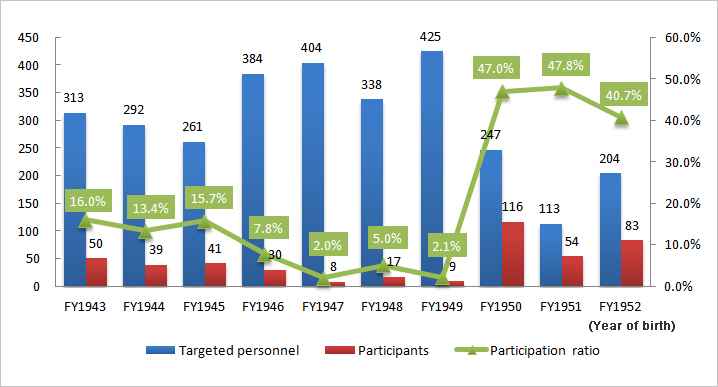 Table: Employees Aged 60 or Higher
Table: Employees Aged 60 or Higher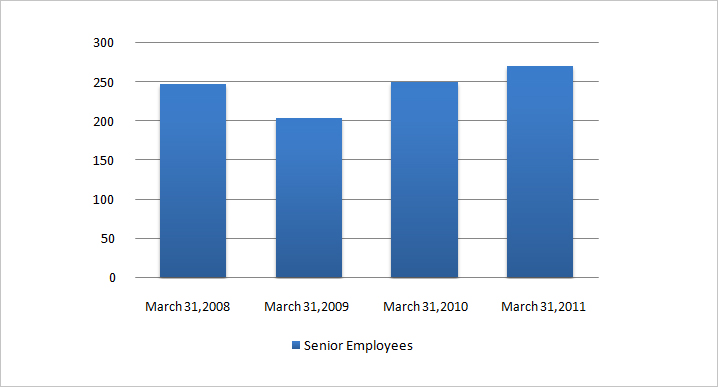
Promoting Local Hiring Overseas
As Fuji Electric’s overseas sales are expanding, particularly in China and other parts of Asia, we are strategically deploying more personnel overseas. We promote local hiring of people overseas, in addition to shifting employees from Japan, particularly among core personnel. Our overseas hiring ratio dipped in FY2010, because our rapid business expansion in China necessitated a concentrated expansion in overseas assignments.
In FY2011, we will redouble our direct overseas hiring efforts to ensure that management strategies and decision-making are appropriate for overseas markets, as well as to boost motivation among locally hired personnel.
Table: Overseas Employees (Regular Employees) (As of March 31, 2011)
| Locally Hired Employees | Percentage of Management-Level Employees Hired Locally | |
| China | 3,121 | 85% |
| Asia (excluding China) | 2,896 | 68% |
| Americas | 82 | 71% |
| Europe | 64 | 56% |
| Total | 6,163 | 70% |
Promotion of a Work-Life Balance
Promoting Deliberation between Employees and Management
Fuji Electric launched the Labor and Management Investigative Committee in Japan in FY2008 to encourage workers and managers to discuss their positions and work together to address the issues they face.
We currently are dealing with two major issues: work-style innovation and enhancement of a support system to provide fulfillment in and outside of work. Labor and management are deliberating proposals that the Company has created and presented to improve systems and the corporate culture.
Promoting Work-Style Innovation in Japan
Work-style innovations were launched in the second half of FY2008, primarily addressing holiday work and extended working hours in an attempt to improve productivity and time value.
Fuji Electric has concluded so-called “36 (Saburoku) Agreements*” with each operational site, as prescribed in the covenants of Article 36 of Japan’s Labor Standards Act covering overtime work and work on rest days. To achieve working styles that limit overtime work to 45 hours per month and 540 hours per year, we have also established no-overtime days, or are reducing overtime work by analyzing the amounts of overtime hours worked at each of our operational sites.
* 36 (Saburoku) Agreements
In principle, maximum employee working hours are eight hours per day, 40 hours per week. In order to extend these hours, an agreement must be reached with a representative of a majority of employees or the labor union and a copy of this agreement submitted to the Labor Standards Inspection Office.
Supporting Fulfillment in and outside Work
In FY2010, we introduced a Time Unit System in Japan for annual paid leave (available up to four days per year and limited to the use of childcare and the nursing of family members. We also set up a leave system for use in the event that a spouse is posted overseas.
We also continued supporting efforts to balance the workplace and family by strengthening communication between supervisors and subordinates. This initiative targeting employees who have returned from childcare leave and their supervisors involves learning from employees who have experienced such a return and their supervisors, discussing current circumstances and the returning employee’s career plans. We held nine such dialogs during the year, involving 30 groups of people.
We will work to raise employee awareness of this system and make it easier to use. At the same time, we will concentrate on improving the workplace environment and monitoring the results of these efforts.
Number of Participants in Childcare and Nursing Support Systems(in Japan)
| FY2005 | FY2006 | FY2007 | FY2008 | FY2009 | FY2010 | |
|---|---|---|---|---|---|---|
| Childcare leave | 150 | 144 | 150 | 143 | 152 | 132 |
| Shorter working hours for childcare | 71 | 72 | 74 | 94 | 110 | 143 |
| Nursing leave | 2 | 6 | 3 | 3 | 4 | 3 |
Scope: Approximately 19,000 employees in major domestic companies
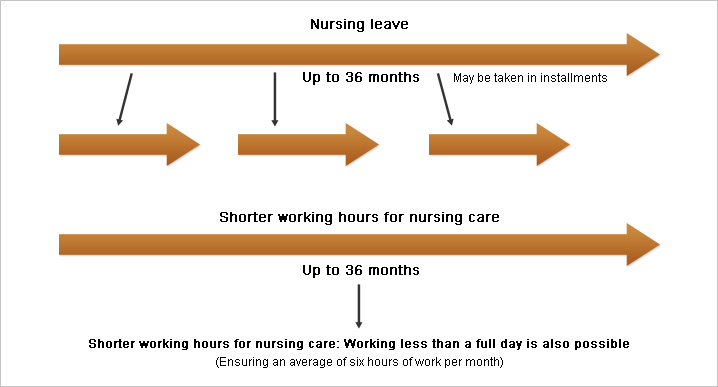
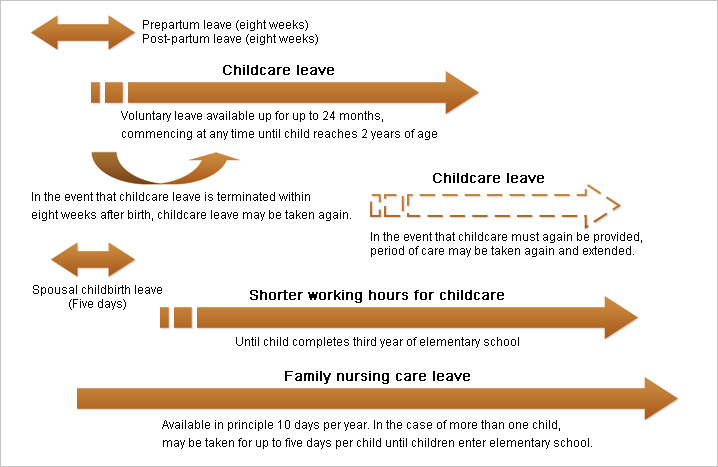
Promoting Diversity
In February 2006, we set up a working group in Japan reporting to the president of Fuji Electric (the former Fuji Electric Holdings) to utilize women’s skills more effectively. As part of the ongoing extension of the group’s activities, in October 2010 we assigned to diversity promotion managers within the Human Resources Department the task of clearly communicating internally and outside the Company our stance on the importance of diversity.
At the same time, in FY2010 we conducted training sessions themed on workplace communication that were designed to promote an improved awareness of diversity. We also held training related to the importance of promoting diversity and the role of management, among numerous other measures. We will continue expanding this theme to create a culture that welcomes diverse human resources.
Table: Principal Activities in FY2010 (in Japan)
Training Sessions
| Themes | Number of Participants |
|---|---|
| The oddities of men and women as viewed through brain science | Fukiage factory: 200 (including president of Fuji Electric FA Components & Systems Co., Ltd.) |
| Normal for me, normal for you | ・Chubu Branch: 80 (including Chubu Branch manager) |
| ・Tokyo factory: 130 |
Manager Awareness Enhancement Training
| Times | Four |
|---|---|
| Participants | All managers, business leaders or above, at targeted worksites |
| Number of participants | 78 |
| Overview | Promoted an understanding of the need for diversity, the current situation in this regard and the importance of management’s role |
Questionnaire on Women’s Activities and Diversity Promotion
| Targeted personnel | Two out of three male employees, all female employees, all line managers |
|---|---|
| Number of people who responded and response rate |
・Men: 3,206 (49%) |
| ・Women: 1,037 (63%) | |
| ・Managers: 695 (69%) |
Events
| Event | Content |
|---|---|
| Photo contest | Photo contest by male employees of Fuji Electric who are taking part in housework and childcare |
| Solicitation of messages | In one area of the Company newsletter, solicited messages to encourage men to take part in housework and childcare |
The Development of Human Resources and Fair Evaluation
Basic Policy on the Development of Human Resources
Investing in the skills and educational development of employees is one of Fuji Electric’s most important themes. Accordingly, we focus on education and training to cultivate highly employable and professional human resources.
Education and Training System
Fuji Electric divides employee education and training into the main categories of courses for employees at different levels within the organization; selective courses; and specialist courses for technical staff, salespeople and people in administrative roles.
Selective courses target potential leaders in various categories, such as department heads, section heads and younger leaders. More than 1,100 people have benefited from this training to date.
Technical training is provided on the job, along with a curriculum geared to boost our technological prowess. The program includes basic technology training for employees in specialized technical areas; core technology training courses targeting engineers, who are a major source of competitive advantage; and companywide technology seminars and other events aiming to provide engineers with greater insight into various technical issues.
For the first year after joining the Company, we provide technical training for engineers involved directly in manufacturing. We also conduct courses in a planned curriculum that includes job- and level-specific training from a manufacturing perspective, and courses designed to enhance technical skills.
Chart: Training System
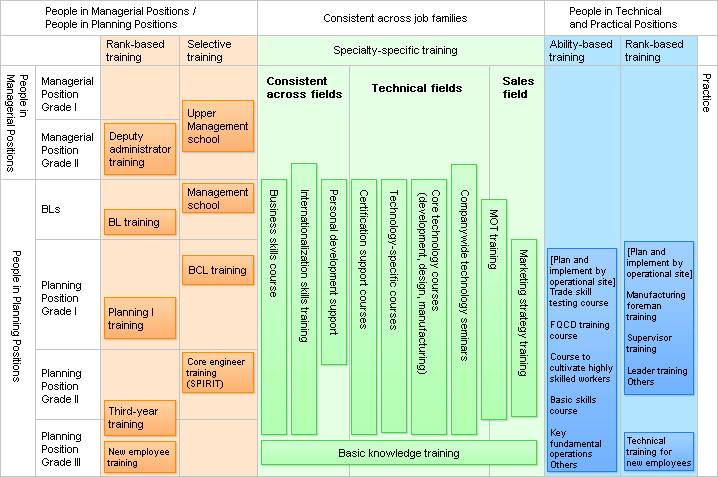
BL: Business leader
BCL: Business core leader
Remuneration System
In FY2004, Fuji Electric put in place a personnel remuneration system in Japan aimed at rewarding employees for results and corresponding to the value of their work. Now, we have in place a more fair-minded system in which compensation reflects two types of evaluation—a performance evaluation assessing the results of an employee’s efforts, as well as an evaluation of the processes used to achieve these results. To ensure that this system is deployed throughout our operations, managers are apprised of the system’s objectives and details; we also hold briefing sessions for employees in this regard.
Results and process evaluations commence with employees self-assessments, which are followed by primary and secondary evaluations by managers. Employees and managers conduct interviews, following items on an interview checklist that covers an evaluation of current performance and considerations for the future. These are shared with the person being evaluated to ensure fairness and mutual understanding.
Safety and Health Management for Employees
Occupational Health and Safety
Fuji Electric’s employees are united in a drive to ensure that safety and health activities are effective.
Companywide Safety and Health Management Policy
Each year, Fuji Electric formulates a Companywide Safety and Health Management Policy, based on risk assessments, that forms an important pillar of the Company’s occupational health and safety activities. The policy’s aim is to encourage risk assessments based on actual workplaces and operations, instill awareness and establish procedures, and entrench actions that will themselves lead to better results. Topmost among the policy’s priority categories is the elimination of serious and recurrent accidents. Our approach toward this goal is to ensure that all employees accurately understand the risk assessments so that they can help to determine the sources of any potential hazards in their working environment and working procedures and take steps to prevent accidents from occurring. We also indicate clearly the sources of specific accidents, incidents and near misses to prevent recurrence.
Fuji Electric promptly notifies all operational sites of its policy and ensures that the policy is thoroughly in place by taking regular opportunities to present it at meetings of various sorts. The policy is also posted on the intranet and the safety department’s website, ensuring that all employees see it.
Manufacturing sites take the Companywide Safety and Health Management Policy as their basis for formulating implementation and training plans, based on their progress and current status as measured against the policy.
Health and Safety Promotion Committee
As Fuji Electric considers worker safety and health one of its topmost management priorities, the Company has established a companywide Health and Safety Promotion Committee. This committee meets annually to review health and safety activities and deliberate health and safety management policies.
In FY2010, the committee met in February 2011 to review reports on health and safety activities and to deliberate on and approve a Health and Safety Management Policy, Priority Health and Safety Categories and an annual slogan, all of which go into effect in FY2011.
FY2011 Priority Health and Safety Categories
- Eliminate serious and recurrent accidents
- Formulate a safety and health management structure for the new organization
- local health and safety management
- Enhance safety and health management at overseas operational sites and among people stationed overseas and local employees
- Strengthen occupational health management
Measures at Sites in Japan
At operating sites in Japan, we have introduced the danger prediction and risk assessment method to eliminate risks that have the potential to cause occupational accidents. This grass-roots safety approach toward machinery and equipment has been highly successful.
During FY2010, our safety department and companywide training departments cooperating in conducting risk assessment training nine times at factories for a total of 222 people in related divisions. Thanks to increased safety awareness, occupational accidents were down in FY2010.
Graph: Frequency Ratio of Days Lost to Accidents or Disasters (in Japan)
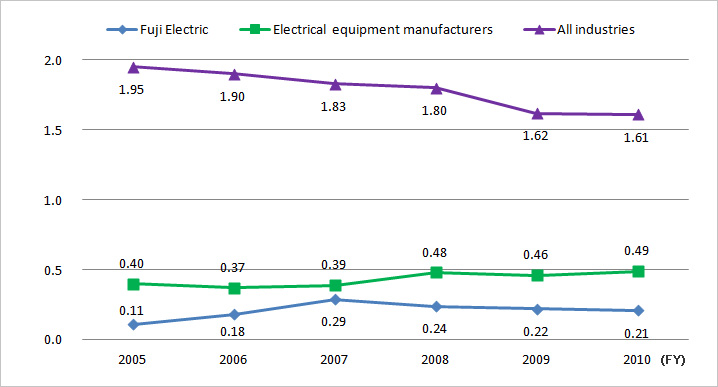
Scope: Fuji Electric Co., Ltd., Fuji Electric FA Components & Systems Co., Ltd., Fuji Electric Retail Systems Co., Ltd.
Measures at Overseas Subsidiaries
Fuji Electric is taking measures to ensure worker safety and health at overseas operational sites.
In FY2010, we conducted safety and health consultations in June 2010 at two overseas production bases, Fuji Electric Semiconductor (Malaysia) Sdn. Bhd. and Fuji Electric (Malaysia) Sdn. Bhd. The overall results were positive, but two items were cited for improvement, one related to the working environment. In FY2011, we plan to conduct safety and health consultations at manufacturing bases in Malaysia and China.
We also conduct regular health checks aimed at maintaining or improving the physical and mental wellbeing of employees stationed overseas and their families. In FY2010, only 65.5% underwent such checks, but by strengthening communications between overseas operational sites and Human Resource Department and health management staff we aim to raise this level to 100% in FY2011.
Health Management and Mental Healthcare
Fuji Electric is working to enhance its line-care/self-care education for employees. In FY2010, we carried out educational programs 39 times for 1,557 employees throughout the Group in Japan. These included training to heighten awareness of stress and depression, study sessions for managers to highlight proper response to mental health problems and groupwork for employees in the 30 to 35 age bracket.
In addition, the heads of departments and personnel and administrative divisions, internal industrial doctors and nurses n cooperation with external healthcare and other organizations, operate a consultation and guidance system to complement efforts to facilitate a smooth return to work and prevention of recurrence for employees taking time off due to illness.
Communicating with Employees
Workplace Communications
Two vital elements for a workplace that supports a diverse employee base are lively communications. We are striving to invigorate workplace communications, as they form the base for a host of corporate activities.
In May 2010, we conducted a Work I Want to Do Survey for employees. After asking employees what work they would like to do, we do our best to place them in positions where they can meet those objectives. The questionnaire was distributed to 14,281 employees, of whom 13,480 responded, for a response rate of 94.4%.
We also conducted an employee awareness survey from December 2010 through February 2011. This survey was sent to 14,471 employees. Responses were obtained from 13,817 people, resulting in a response rate of 95.5%.
Through such efforts to gather feedback from employees and respect their wishes, we are creating a working environment that allows employees to maximize their potential.
Labor–Management Communications (in Japan)
Organizational Changes at the Labor Union in Line with Management Framework Restructuring
In April 2011, Fuji Electric reorganized its management structure, starting with ending its employment of the pure holding company system. In the past, each operating company had its own labor union to allow discussion of management issues and working conditions specific to individual operating companies to be discussed separately from those management issues and working conditions common throughout the Group. The Fuji Electric Group Labor Union served as the overarching organization.
In line with the management framework restructuring at Fuji Electric, the labor union is set to undergo an organizational revision in October 2011. Fuji Electric is also considering a structure and consultative format that will be foster even more suitable labor–management relations.
As of March 31, 2011, 13,774 employees were members of the Fuji Electric Group Labor Union.
Labor–Management Consultations in FY2010
In preparation for the April 2011 revision of the Company’s management framework, in FY2010 labor and management consulted and shared opinions regarding the goals that the new business management would require and discussed individual company differences in working conditions and compensation.
We also discussed revisions to certain systems aimed at improving the work–life balance.

-
- Corporate Profile
- CSR
- Management Structure
- Social Report
- Environmental Report
- Topic 1/Reducing Environmental Impact through Our Products
- Topic 2/Reducing Environmental Impact at Our Production Bases
- Environmental Management
- Environmental Management Targets and Results
- Interplay between Business Activities and Environmental Impact
- Preventing Global Warming
- Recycling of Resources
- Management of Chemical Substances
- Preservation of Biodiversity
- Reducing Environmental Impact through Fuji Electric Products
- Together with Local Communities
- Research & Development

